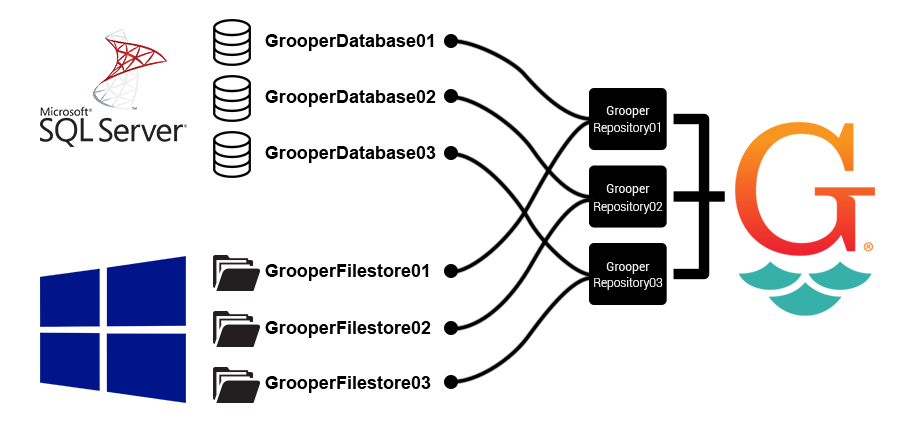2023.1:Grooper Infrastructure (Concept): Difference between revisions
Configadmin (talk | contribs) No edit summary |
Configadmin (talk | contribs) No edit summary |
||
| Line 32: | Line 32: | ||
# [http://okcspwik01/grooperwiki/index.php?title=Grooper_Attended_Client Grooper Attended Client] | # [http://okcspwik01/grooperwiki/index.php?title=Grooper_Attended_Client Grooper Attended Client] | ||
# [http://okcspwik01/grooperwiki/index.php?title=Grooper_Unattended_ClientGrooper Unattended Client] | # [http://okcspwik01/grooperwiki/index.php?title=Grooper_Unattended_ClientGrooper Unattended Client] | ||
In discussing the overall picture of infrastructure, let’s focus on Grooper Design Studio for a moment, as it is the piece you will use most directly as you are developing processes. Every object in the Grooper [http://okcspwik01/grooperwiki/index.php?title=Node_Tree Node Tree] is an object, or row, in a specific table, the dbo.TreeNode table. The [https://en.wikipedia.org/wiki/Graphical_user_interface GUI] of Grooper is essentially wrapping information from the Grooper database | In discussing the overall picture of infrastructure, let’s focus on Grooper Design Studio for a moment, as it is the piece you will use most directly as you are developing processes. Every object in the Grooper [http://okcspwik01/grooperwiki/index.php?title=Node_Tree Node Tree] is an object, or [https://en.wikipedia.org/wiki/Row_(database) row], in a specific table, the dbo.TreeNode table. The [https://en.wikipedia.org/wiki/Graphical_user_interface GUI] of Grooper is essentially wrapping information from the Grooper database, and associated files from the Grooper File Store, into a series of grids and windows that allow you to directly interact with that database, and its related Windows file share, without writing SQL queries. | ||
Revision as of 09:07, 6 January 2020
What is Grooper? Grooper is a repository of information made up by a SQL Server Database and a Windows file share. This information is displayed to the user via an application(s) that displays a 1 to 1 relationship of what exists in that database and fileshare. Gaining an understanding of how to properly create using Grooper begins by first understanding the structure of its architecture, and why it is built the way it is. This sets a foundational groundwork for knowing how to think and interact with the application.
The Three Layers of Grooper
Grooper consists of three main components that constantly interact with one another:
- Database
- Filestore
- Application
The Database
This is the core component of Grooper as all aspects of the functionality and configuration of a Grooper repository are stored here as metadata in cells of tables. There are 13 tables that make up the Grooper database:
- AccessControlEntry
- CustomStats
- FileStoreEntry
- License
- LicenseCheckout
- Lock
- Log
- NodeReference
- ProcessingTask
- ServiceInstance
- SessionStats
The File Store
The File Store in Grooper is a file share in a Windows environment. It houses the files associated with objects in Grooper that have information that would otherwise be inefficient to store in (a cell in) a database table.
The Application
This is the most visible aspect of Grooper as it is the software you interact with that displays the currently active repository. It consists of several pieces:
In discussing the overall picture of infrastructure, let’s focus on Grooper Design Studio for a moment, as it is the piece you will use most directly as you are developing processes. Every object in the Grooper Node Tree is an object, or row, in a specific table, the dbo.TreeNode table. The GUI of Grooper is essentially wrapping information from the Grooper database, and associated files from the Grooper File Store, into a series of grids and windows that allow you to directly interact with that database, and its related Windows file share, without writing SQL queries.

